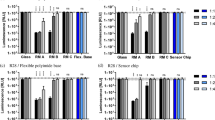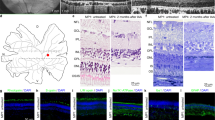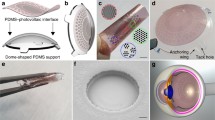Abstract
Background
The development of a visual prosthesis aims to restore partial vision in patients with diseases which lead to total photoreceptor loss. The wireless power supply for a retinal implant may be realized with electromagnetic induction or with optical energy transfer. The present study investigates the feasibility of a photovoltaic power generation in the intraocular lens (IOL) part of an epiretinal implant for long-term tests in rabbits.
Methods
IOLs containing an array of photovoltaic cells (PVC) and a light-emitting diode (LED) were implanted into the capsular bag after phacoemulsification in three chinchilla rabbits. Optical energy transfer was established with an infrared laser beam at 850 nm wavelength. Lighting up of the LED proved the functioning of the PVC array. The maximum duration of in vivo functioning of the implant was determined by regular tests involving laser beam application. The explanted microsystems were technically analyzed. Tissues of both eyes underwent routine histological examinations.
Results
The lifespan of the microsystems ranged from 14 days to more than 7 months. Final malfunction was caused by PVC defects or by defective contacts between PVC and LED that may originate from the low adhesive strength between the silicone cover and the underlying electronic components. The histological examination showed no alterations of the retinal structure in the treated eyes.
Conclusions
The power supply for intraocular microsystems by an array of photovoltaic cells was proven to be feasible in long-term tests in rabbits. An essential prerequisite for a future device is hermetic coating of the electronics.





Similar content being viewed by others
References
Birngruber R, Gabel VP (1983) Thermal versus photochemical damage in the retina—thermal calculations for exposure limits. Trans Ophthalmol Soc U K 103: 422–427
Chow AY, Chow VY (1997) Subretinal electrical stimulation of the rabbit retina. Neurosci Lett 225:13–16
Chow AY, Chow VY, Pardue MT, Perlman JI, Peachey NS (1998) Retinal and cortical potentials induced by subretinally implanted microphotodiode arrays. Invest Ophthalmol Vis Sci 39: S565
Eckmiller R (1997) Learning retina implants with epiretinal contacts. Ophthalmic Res 29:281–289
Hämmerle H, Kobuch K, Kohler K, Nisch W, Sachs H, Stelzle M (2002) Biostability of micro-photodiode arrays for subretinal implantation. Biomaterials 23:797–804
Humayun MS, de Juan E, Jr., Dagnelie G, Greenberg RJ, Propst RH, Phillips DH (1996) Visual perception elicited by electrical stimulation of retina in blind humans. Arch Ophthalmol 114:40–46
Loeb GE, Bak MJ, Salcman M, Schmidt EM (1977) Parylene as a chronically stable, reproducible microelectrode insulator. IEEE Trans Biomed Eng 24:121–128
Margalit E, Maia M, Weiland JD, Greenberg RJ, Fujii GY, Torres G, Piyathaisere DV, O’Hearn TM, Liu W, Lazzi G, Dagnelie G, Scribner DA, de Juan E Jr, Humayun MS (2002) Retinal prosthesis for the blind. Surv Ophthalmol 47:335–356
Moore K, Graham M, Barr M (1953) The detection of chromosomal sex in hermaphrodites from a skin biopsy. Surg Gynecol Obstet 96:641–648
Peachey NS, Chow AY (1999) Subretinal implantation of semiconductor-based photodiodes: progress and challenges. J Rehabil Res Dev 36:371–376
Rizzo JF, Wyatt JL (1997) Prospects for a visual prosthesis. Neuroscientist 3:251–262
Rizzo JF, Wyatt JL (1999) Retinal prosthesis. In: Maguire MG (ed) Age-related macular degeneration. Mosby, St. Louis, pp 413–432
Stieglitz T, Beutel H, Keller R, Blau C, Meyer J-U (1997) Development of flexible stimulation devices for a retina implant system. Proceedings of the 19th Annual International Conference of the IEEE Engineering in Medicine and Biology Society, 30 Oct–2 Nov 1997, Chicago, pp 2307–2310
Stieglitz T, Beutel H, Schuettler M, Meyer JU (2000) Micromachined, polyimide-based devices for flexible neural interfaces. Biomedical Microdevices 2:283–294
Stieglitz T, Keller R, Beutel H, Meyer J-U (2000) Microsystem integration techniques for intraocular vision prostheses using flexible polyimide-foils. Proceedings of MICRO.tec 2000, 25–27 September, Hannover, Germany, pp 467–472
Stieglitz T, Kammer S, Koch KP, Wien S, Robitzki A (2002) Encapsulation of flexible biomedical microdevices with Parylene C. Proceedings of the 7th Annual International Conference of the International Functional Electrical Stimulation Society, 25–29 June 2002, Ljubljana, Slowenia, pp 231–233
Walter P, Heimann K (2000) Evoked cortical potentials after electrical stimulation of the inner retina in rabbits. Graefes Arch Clin Exp Ophthalmol 238:315–318
Yuen TG, Agnew WF, Bullara LA (1987) Tissue response to potential neuroprosthetic materials implanted subdurally. Biomaterials 8:138–141
Zrenner E (2002) Will retinal implants restore vision? Science 295:1022–1025
Zrenner E, Stett A, Weiss S, Aramant RB, Guenther E, Kohler K, Miliczek KD, Seiler MJ, Haemmerle H (1999) Can subretinal microphotodiodes successfully replace degenerated photoreceptors? Vision Res 39:2555–2567
Acknowledgement
Financial support: BMBF grant to the EPI-RET research group, Germany
Author information
Authors and Affiliations
Corresponding author
Rights and permissions
About this article
Cite this article
Laube, T., Brockmann, C., Buß, R. et al. Optical energy transfer for intraocular microsystems studied in rabbits. Graefe's Arch Clin Exp Ophthalmol 242, 661–667 (2004). https://doi.org/10.1007/s00417-004-0909-8
Received:
Revised:
Accepted:
Published:
Issue Date:
DOI: https://doi.org/10.1007/s00417-004-0909-8




